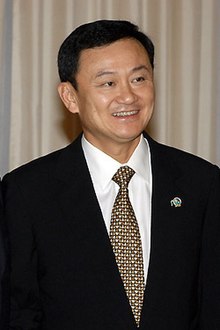Palang Dharma Party
Phalang Dharma ( Thai พรรค พลัง ธรรม , Thai transcription system : Phak Phalang Tham , pronunciation: [ pʰák pʰá.laŋ tʰam ] - "Power of the Dharma Party" or "Party of Moral Force") was a Buddhist- oriented party in Thailand . It was founded in 1988 by Chamlong Srimuang and was associated with the Buddhist sect Santi Asoke . During the early 1990s, Palang Dharma was a major force in Thai politics.
Foundation and first successes
The party was founded by Major General Chamlong, who was then governor of Bangkok and who led an ascetic life as a devout Buddhist. He founded the party in an effort to “cleanse” Thai politics of the rampant corruption that was often used to justify military coups. With Palang Dharma a new type of politics entered Thailand. The party program explicitly referred to Buddhist principles. The fame of its leader, however, contributed more to the success of the party than its program. Palang Dharma was particularly popular with the middle class in the greater Bangkok area . There she won 49 of the 55 seats in the 1990 city council election and 32 of the 35 seats in the parliamentary election in September 1992. The latter was the party's greatest success. Nationwide, it won over 9 million votes (18%) and 47 of the 360 seats. Party leader Chamlong was a key figure in the middle-class mass protests against the military-backed government of Suchinda Kraprayoon in Black May 1992 that led to Suchinda's resignation.
Inner-party wings
The party was split into a so-called “temple faction” of Santi Asoke members, who strictly insisted on their principles and refused to compromise, and a more pragmatic wing of secular politicians who sought to grow the party and advance their careers. The "temple faction" fought against the influence of money on Thai politics and preached self-sacrifice, diligence, honesty and morality. In return, she accepted that the party could remain a small, insignificant opposition party. The secular wing of the so-called “career remnants”, on the other hand, believed that in order to influence the direction of the country's development, the party would have to expand, take on skilled experts and business people, make alliances and join the government. The “temple faction” considered the pragmatists to be opportunistic and suspected that they only wanted to profit from the good reputation of the party and its leader. The “careerists”, on the other hand, considered the religious to be naive, unrealistic and ineligible if they competed alone.
The party leader Chamlong took advantage of these wing battles. He played the two camps off against each other in order to defend and expand his top position. He put convincing, sensible-looking experts on as top candidates and at the same time left the “temple faction” the role of the conscience of the party, which tamed the elected representatives and kept them from pursuing their own interests. Chamlong also manipulated internal party elections and threatened to resign if he saw his leadership role in question.
Government participation
In 1992, Chamlong handed over the leadership of the party to the large entrepreneur and former politician of the social action party Boonchu Rojanastien , but remained the de facto leader of the party until 1995. After the parliamentary elections in September 1992, Palang Dharma joined the ruling coalition under Chuan Leekpai and his Democratic Party . In 1995, however, they left the coalition and thus brought about the end of the government. Already in 1994 it had lost the majority in the Bangkok city council to the right-wing, military-affiliated Thai civil party . Some members left the party and telecommunications entrepreneur Thaksin Shinawatra , Thailand's richest businessman and representative of the pragmatic wing of the party, took over.
Decline
Under Thaksin, the party turned from its religious roots and joined the coalition government of Banharn Silpa-archa , in which Thaksin was deputy prime minister. During this time the party dwindled. The internal party conflicts led to its collapse in 1996. Chamlong ran again for the election of the governor of Bangkok, but lost and withdrew from active politics. Buddhist-inspired criticism of established politics, as represented by Palang Dharma, and Chamlong's commitment to “clean politics” can, however, be seen as important impulses for the 1997 new Thai constitution .
In 1998 Thaksin Shinawatra founded the Thai Rak Thai party , which was joined by a number of former Palang Dharma parties.
former members
- Jatuporn Prompan , leader of the “ red shirt ” movement since 2008
literature
- Michael Leifer: Dictionary of the modern politics of South-East Asia . Routledge, London 1996, ISBN 0-415-13821-3 , p. 125. Keyword: "Palang Dharma".
- Duncan McCargo : Chamlong Srimuang and the New Thai Politics. Hurst and St. Martin's Press, London / New York 1997.
Individual evidence
- ^ Wolfgang Muno: Reform politics in young democracies. Veto players, political blockades and reforms in Argentina, Uruguay and Thailand. VS Verlag für Sozialwissenschaften, 2005, p. 191.
- ↑ a b c Tun-jen Cheng, Deborah A. Brown: Introduction. The Roles of Religious Organizations in Asian Democratization. In: Religious organizations and democratization. ME Sharpe, 2006, p. 19.
- ↑ a b c Duncan McCargo: Thailand's political parties. Real, authentic and actual. In: Political Change in Thailand. Democracy and Participation. Routledge, 1997, pp. 124-127
- ↑ a b c d e f g David Ambuel: New Karma. Buddhism and Democratization in Thailand. In: Religious organizations and democratization. ME Sharpe, 2006, pp. 93-94.
- ^ A b c Michael Leifer: Dictionary of the modern politics of South-East Asia . Routledge, 1996, p. 125. Keyword: "Palang Dharma".
